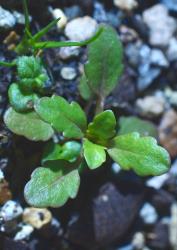Annual herb to 0.2 m tall. Stems ascending to erect, glabrous. Leaf bud indistinct; leaves separating while very small, few, short-lived, opposite-decussate, erecto-patent to reflexed; lamina thin to sub-coriaceous, elliptic to oblanceolate below, becoming narrowly oblong to linear-oblanceolate above, 6–20 mm long, 1.5–7.0 mm wide, slightly glossy green or reddish above, dull pale green or green beneath; midrib and lateral veins obscure; surfaces glabrous; margin glabrous, bluntly shallowly serrate to crenate below, becoming entire above; teeth in 0–4 pairs; apex rounded to bluntly acute; base cuneate; petiole 4–6 mm long in lowest leaves, becoming absent above. Inflorescence a terminal raceme, 30–150 mm long; flowers crowded at first, becoming more distant at fruiting, 8–35, all bisexual; bracts alternate, linear to linear-oblanceolate, > pedicels; pedicels erecto-patent, 0.2–0.5 mm long, glabrous. Calyx lobes 4, obtuse to bluntly acute or acuminate, 1.5–2.5 mm long, unequal, enlarging to 2–4 mm long at fruiting, glabrous. Corolla 1.5–2.5 mm diameter; tube white, c. 0.5 mm long, < calyx, glabrous; lobes 4, white, erect or sub-erect, equal to sub-equal, broadly oblong to broadly elliptic, 1.5–2.0 mm long, rounded; nectar guides absent. Stamen filaments white, c. 0.5 mm long; anthers cream to buff. Style glabrous, 0.1–0.2 mm long. Capsules angustiseptate, shallowly emarginate to obcordate, glabrous, 2.5–3.0 mm long, 3.5–4.5 mm at widest point. Seeds ellipsoid to oblong, flattened with a rounded ridge ¾ of length on back, smooth, pale brown, 0.6–0.8 mm long.
The combination of very small, white flowers, with corolla included in the calyx, and completely glabrous in all its parts is distinctive for identifying plants of V. peregrina. At fruiting, the capsules are distinctive in being glabrous, broader than long, shallowly emarginate or obcordate, and having very short styles.
North Island: Auckland (Western Springs, Oratia); Volcanic Plateau (Tauranga); Southern North Island (Kākāriki).
Footpath cracks and between pavers (Western Springs), a nursery weed (Oratia), and seasonally wet hollows in gravel and silty soil (Tauranga, Kākāriki). Recorded elevations range from 10 to 85 m.
| Category | Number |
|---|---|
| Exotic: Fully Naturalised | 1 |
| Total | 1 |
Heenan et al. (2004, p. 809). Voucher CHR 568457, C. C. Ogle 4411, Kākāriki.
Flowers: September–November (and probably earlier); fruits: September–December.
2n = 52 (-54?) (New Zealand plants not counted; see Albach et al. 2008).
Veronica peregrina is classified in V. subg. Beccabunga (Albach et al. 2004; Albach & Meudt 2010) along with V. americana, V. anagallis-aquatica, V. catenata and V. serpyllifolia.
V. peregrina plants are short-lived annuals that probably mostly die by early summer when their habitat dries up. In cultivation, new seedlings appeared again in March, which suggests autumn plants might also occur in the wild. Self-sown plants in pots in a Wellington garden flowered in June.
The flowers are mostly cleistogamous and open only on warm, sunny days for an hour or two about midday. Otherwise they self-pollinate without opening, as the anthers are held against the stigma. Fruits mature and dehisce very quickly.
Plants in New Zealand are glabrous, thus matching V. peregrina var. peregrina.




